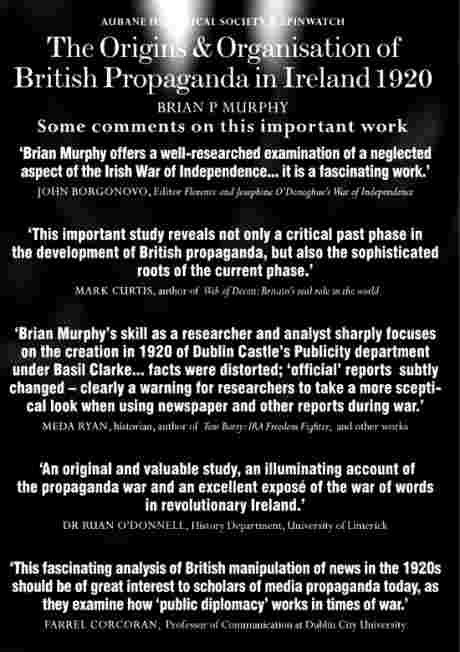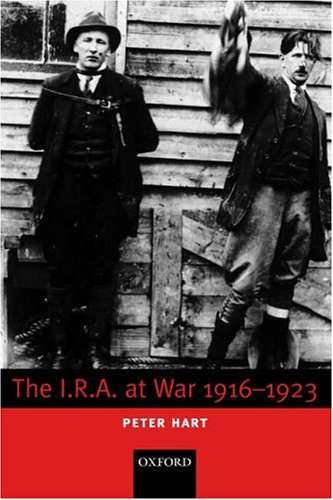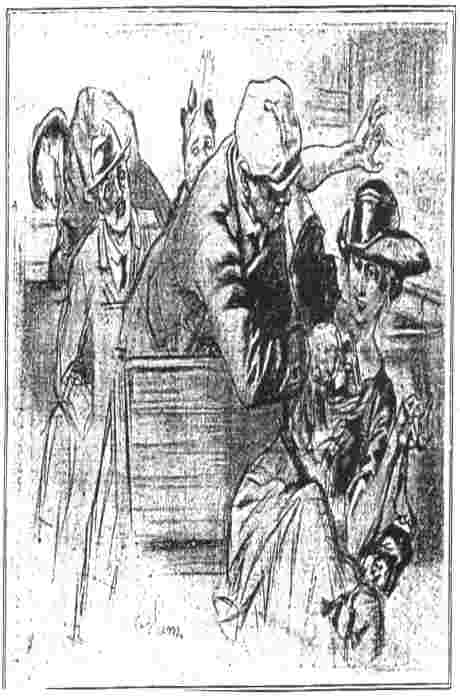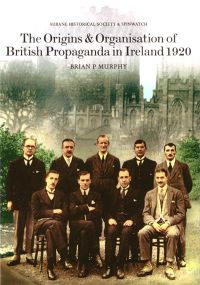Imperialist Propaganda (Then and Now)
 national |
rights, freedoms and repression |
feature
national |
rights, freedoms and repression |
feature  Thursday March 30, 2006 03:22
Thursday March 30, 2006 03:22 by Niall Meehan
by Niall Meehan
Launch of The Origin and Organisation of British Propaganda in Ireland 1920
Reading Brian Murphy on how the British manipulated the truth in 1920 "made the hairs stand up on the back of your neck" said Danny Morrison. The parallels between events in that one year and British activities many years later in Ireland are striking, he said.
The one time An Phoblacht editor and Sinn Fein Publicity Director, now author and playwright, launched Brian Murphy's 'The Origins and Organisation of British Propaganda in Ireland 1920’ on March 24th in the Teachers’ Club in Dublin.
The 100-page work was also launched by Professor David Miller of Strathclyde University and by the author, Brian Murphy.
Morrison detailed the way in which Murphy's book outlines how the British plotted to kill a solicitor who defended IRA prisoners, how they abolished inquests and how they utilised the "language of criminalisation" in the attempt to marginalise resistance to British rule. The false accusation that prisoners' injuries were "self-inflicted" was the same as that attributed to prisoners in Castlereagh in the 1970s, said Morrison. The Defence of the realm Act (DORA) and the Restoration of Order in Ireland Act (ROIA) legislation would also be familiar to those who experienced or studied the recent conflict.
Damned lies and statistics
Reading Murphy’s account of the British manipulation of statistics with regard to IRA actions called for a reconsideration of recent statistics on the conflict in the North, said Morrison. Killings attributed to the UDA or UVF should rightfully be attributed directly to British forces, which set up and controlled such paramilitary proxy forces or ‘counter gangs’. Morrison mentioned the attempt on the life of former Sinn Fein Lord Mayor of Belfast, Alex Maskey. British agent Brian Nelson, who telephoned British Army Headquarters in Lisburn to confirm Maskey’s identity, coordinated the unsuccessful attempt. Morrison referred to Sir John Stevens of the British Metropolitan Police who spent 15 years, or one third of his professional life, investigating British collusion with unionist paramilitaries. Stevens published 17 pages of a 3,000 page report. Morrison asked, “How much more is in there?”.
The point leads directly to the question: who should the 34 deaths in the 1974 Dublin-Monaghan bombings be attributed to statistically: the UVF, the RUC, the British Army, or all three?
How the truth was “mutilated”
Morrison said that Brian Murphy’s book should be commended for the way in which it showed how the British created a “false narrative” about the conflict and how modern history books reproduced that narrative. Morrison referred to the “official” account of British soldiers being “hacked to death” and of “mutilated” bodies after the IRA’s Kilmichael ambush in November 1920, an account that was the concoction of the chief propagandist, Basil Clarke. This is the account that revisionist historian Peter Hart asserted “should not be so completely dismissed” in his ‘The IRA and its Enemies’ (1998). Besides Hart, the historians Roy Foster and David Fitzpatrick were mentioned in this context.
The book contains an appendix in which Brian Murphy questions Peter Hart’s omission of a section from an internal British intelligence document, The Record of the Rebellion, detailing British forces’ racist and sectarian view of the Irish. This is in Hart’s edition of The Record, entitled British Intelligence in Ireland 1920-21 (2002). Murphy, in addition, questions Hart’s failure in this book to account for a previous misrepresentation of a section of The Record in Hart’s The IRA and its Enemies. An Irish Times reviewer of Hart’s British Intelligence in Ireland, Brendan Ó Cathaóir, referred to Hart as “disingenuous” (28 January 2003) on this point.
Spin yesterday and today
Professor David Miller, co-editor of Spinwatch (http://www.spinwatch.org), contributed a foreword to Murphy’s study and outlined the connection with wider aspects of British policy. Miller has researched extensively the origins of British propaganda and its connection with the development of public relations. Both were originally designed, said Miller, to preserve the British Empire and also to subvert democracy in Britain itself.
Miller outlined how Basil Clarke, who ran the propaganda operation in Ireland, was a key member of British imperialist networks.
According to Miller’s foreword, Clarke and his colleagues, Hugh Pollard and C.J. Street worked closely with the head of Special Branch in London, Basil Thomson.
“Through him they were connected to the key imperialist lobby networks in London. These individuals were not abashed about their politics, describing their network as the ‘diehards’ and the ‘London Imperialists’. Central to it and very close to Thomson was Admiral Reggie ‘Blinker’ Hall, who was the director of Naval Intelligence in the 1914-18 war. Together with Thomson, Hall interrogated Roger Casement in 1916 and personally leaked his ‘black diaries’ to the press in order to ensure that Casement would not be reprieved as a result of the campaign being run by Arthur Conan Doyle. According to historians, Hall’s ensuring that Casement was hanged ‘was all very gratifying; an object lesson in secret service power which Hall… was never to forget’.”
Clarke went on to set up the first public relations company in Britain, and he was associated with the setting up of ‘National Propaganda’, later to become ‘The Economic League’ in 1924. Clarke and his associates recruited former Black & Tans after the war in Ireland to break up strikes and to infiltrate trade unions and left wing organisations. The Economic League was notorious up until its demise in the 1990s for blacklisting workers on a massive scale and for other forms of clandestine reactionary subversion of left wing and industrial politics. Another of the Dublin propaganda group, Hugh Pollard, flew Generalissimo Francisco Franco from the Canaries to Spain in 1936 to enable him to start his fascist coup that lead to the Spanish Civil War and nearly 40 years of brutal dictatorship.
Photographing torture
Miller indicated how propaganda was an essential part of Britain’s attempt to hold on to its empire. He said that lessons on media manipulation were passed on and honed from conflict to conflict. Miller, Editor of ‘Tell me Lies’, which deals with the conflict in Iraq, drew parallels with that conflict. Miller observed:
“One of Murphy's most extraordinary revelations is that the techniques, which shocked the world in Abu Graibh, have a history longer than perhaps anyone outside the military and their political masters has suspected. He quotes the records of the torture of Tom Hales and Patrick Harte who were viciously attacked, kicked, punched, hit with revolver butts and tortured with pincers. They were threatened in a mock execution. As Murphy notes 'attempts were made to humiliate them by making them hold the Union Jack and photographs were taken of Harte with the flag held loosely in his hand'. These photographs still exist, and in a telling aside Murphy simply notes that it is one of these torture photos which adorns the front cover of revisionist historian Peter Hart's book, The IRA at War 1916-1923 (2003).
There were also parallels with the photographs taken of torture by British troops in the 1970s. Miller referred to a recent article by Gerry Adams in The Guardian on this point.
IRA ‘criminality’ in 1920
In his talk on the work Murphy quoted propagandist Major John Street as saying “the IRA rank and file” were “poor dupes of the designing criminals who pose as their officers”. Street’s views are positively civilised beside those of Hugh Pollard: “The Irish problem is a problem of the Irish race, and it is rooted in the racial characteristics of the people themselves,” wrote Pollard in 1922. The Irish he thought were “racially disposed to crime”, have “two psychical and fundamental abnormalities… moral insensibility and want of foresight” which “are the basic characteristic of criminal psychology”. Furthermore, noted Street, warming to his theme, “the Irish demand for an independent Irish Republic is… a purely hysterical manifestation”.
Pinning down Kevin Myers
Murphy outlined how propaganda and media manipulation was organized and how this propaganda ‘spin’ had a shelf life that infected modern day accounts. Kevin Myers in The Irish Times republished one concoction of Clarke’s that attempted to discredit hunger striker Terence MacSwiney. MacSwiney was accused of plotting the assassination of the Bishop of Cork. Uniquely, Myers later apologized for recirculation of this defamatory lie.
However, it was only at the book launch that we found out how and why Myers came to apologise.
MacSwiney’s grandson, spoke during the Q&A session afterwards about how getting the apology published was “not easy”. He accompanied his mother, Maura MacSwiney Brugha, “as her assistant” in pursuing Myers into The Irish Times building and in pinning Myers to a wall, in order to enable Myers to listen to his mother’s account of how he got it totally wrong. Myers was later to admit publicly that he had been “duped” by, “the insidious concoctions of the black propagandist,” Basil Clarke.
However, subsequently, Clarke’s other “insidious concoctions” found in the post-apologetic Myers a willing receptacle for publication of further propaganda.
Myers did not detect Clarke at work in the British account of the Kilmichael ambush. In The IRA and its Enemies Peter Hart thanked Myers for his help. Myers returned the compliment by praising the 1998 revisionist account as a “masterpiece”. Myers wrote in his Irishman’s diary how Tom Barry and the IRA allegedly “systematically slaughtered disarmed RIC Auxiliaries after they had surrendered”. This account, following Peter Hart, is from the Basil Clarke school of media manipulation and, as Clarke puts it, “verisimilitude” or the appearance of truth.
The role of Erskine Childers
Brian Murphy outlined the very significant role of Erskine Childers in exposing publicly the extent of British terror in Ireland. Childers also wrote extensively on the nature of British propaganda as part of the strategy of a military machine. This work deserves to be re-published and perhaps the Aubane Society will consider doing so. Murphy made observations about the significant role of Childers and other Irish Protestants in the national struggle that are still relevant today. They helped expose the nature of British terror and set up organizations like the White Cross Society, founded in 1921 for relief in Ireland. This is another part of the narrative of the Independence struggle that revisionist voices seek to stifle.
Murphy made the point that the mass imprisonment of Sinn Fein members in 1918 in conditions of blanket censorship and other forms of repression makes the election victory that year all the more impressive.
Erskine Childers was astonished at the imprisonment of his cousin, Robert Barton after Barton won a seat in the 1918 General Election. Barton was one of many imprisoned Sinn Fein TDs. The attempt by revisionists to undermine that victory is made seemingly plausible by leaving out these and other important factors. Notably, revisionist critics habitually attempt to suggest that Sinn Fein winning 48% of the first reference vote in 1918 was a true measure of its support. They leave aside the inconvenient fact that 25 seats were uncontested by Sinn Fein’s opponents, so pathetic was the level of (non) support for opponents of the republicans. No vote took place in those seats. A more accurate measure would be closer to 70% Sinn Fein support on the island of Ireland, a truly phenomenal achievement.
Murphy also made the point that the non-appearance in the historical narrative of the role of the ultra repressive ROIA and of its predecessor DORA in 1914, “has also contributed to a flawed analysis” of the causes of the 1916 Easer Rising and of subsequent Irish history.
British Empire and “capitalistic imperialism”
Murphy said that events in Ireland had implications for Britain’s Empire and the policy of developing an Anglo-American alliance. Murphy quoted Childers on the post World War One Paris Peace Conference that resulted in the Treaty of Versailles, a treaty that sowed the seeds of the Second World War. Childers wrote: “it has not been difficult to stifle the voice of Ireland at Paris. Her independence has no market value, while its repression on the grounds of military necessity was the best of all precedents for similar policies elsewhere.” He concluded, “the subjection of Ireland is international poison contaminating the politics of the world”.
Murphy said that “Great Britain was free to develop its empire and its quest for oil in such areas as India, Mesopotamia (modern Iraq) Afghanistan and Africa. The War of Irish Independence was fought out in the context of these and other battles by British forces to make good their claim to these new zones of imperial expansion”.
In the context of the third anniversary of the present Iraq war Murphy said it was “sobering to consider that at that time, the much vaunted Irish-American influence in America counted for nothing in comparison with the powerful Anglo-American interests that dominated the corridors of power in Washington. An interest that still exercises far more sway than the Irish over American policy today, despite the generous gift of Shamrock and Shannon Airport to President Bush”.
Childers said in 1919, “look behind the force that holds down Ireland and you will recognize, in one of its unnumerable forms, the ugly face of capitalistic imperialism”.
Lively discussion
A lively discussion took place afterwards, with speakers asking whether propagandists believe their own propaganda, if there was anything on the situation in the North at the time, on the role of the Internet in creating an alternative view, and observations about how the Irish Times permits letter writers to question Kevin Myers’ use of language but not to correct abuse of the facts. Manus O’Riordan, author of a recent pamphlet on James Connolly, took up Murphy’s invitation to discuss the problem of censorship on the Irish Times letters page. Murphy asserted that he was able to have a letter published recently when “Madam” was “away”, apparently at a funeral.
Danny Morrison suggested that Kevin Myers “as a human being” might change his opinion if he took up Morrison’s invitation to visit West Belfast during the West Belfast Festival and see for himself. Unfortunately, Myers has perennially been unable to take up the invitation, on one occasion, as he informed Morrison, because was unaware that his wife had simultaneously organized a barbeque in the Myers back garden.
Brian Murphy was encouraged by many speakers to continue with his valuable and stimulating research and, as Terence MacSwiney’s grandson put it, to “keep seeking the truth”.
The Origin and Organisation of British Propaganda in Ireland 1920, by Brian Murphy is available from http://www.spinwatch.org and http://www.aubane.org.

Chomsky co-author praises Murphy's study

Some more comments on the book

Torture of Tom Hailes and Patrick Harte - as used by Peter Hart

From Illustrated London News - IRA as depicted in propaganda account
